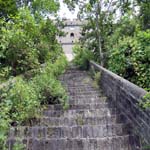Great Wall in Zhangjiakou City
Located In Zhangjiakou City, Hebei Province, there are about thirteen sections of the Great Wall totaling more than 1,470 km (913 miles) and built over eight dynasties, namely the Warring States Period (476 BC-221 BC), Qin (221BC-206BC), Han (206BC-220), Northern Wei (386-534), Northern Qi (550-577), Tang (618-907), Jin(1115-1234) and Ming (1368-1644) dynasties. Two third of the wall is within the Hebei Province or one sixth the total length of the Great Wall of China.
Experts consider Zhangjiakou as the "Great Wall Museum of All Dynasties" because all the constructional styles can be found here. For example, besides the brick laid wall like Badaling, the rammed earth wall and stone piled walls can also be found here. The top of the wall comes in different shapes, such as round, flat, spire and inclined. Its thickness also differs: certain section can accommodate eight people standing shoulder to shoulder, whilst others allow four horses to stand neck to neck. However, other sections are so narrow that it could hardly hold anyone!
The special geographic location determines the presence of a larger section of the Great Wall in Zhangjiakou City. Located in the transitional belt of Mongolian Plateau and North China Plain, this city connects the offshoot of Yinshan Mountain in the west, Yanshan Mountain in the east and is bordered by the northern end of Taihang Mountain in the south. It is a natural boundary between the ancient prairie nomads in North China and the farmers of the Central Plains. The basin in the middle, formed by Sanggan River and Yanghe River, is suitable for large infantry unit to be stationed and moved about. It was this reason that the emperors of all dynasties were actively building walls here.
The Great Wall in Zhangjiakou City was built during the Ming Dynasty as a defensive line along northern Beijing. Historically, Zhangjiakou (originally belonged to Xuanfu Garrison) and areas were the battle grounds where most wars took place. According to statistics, over 50 famous wars and fights occurred here and more than 200 sites of ancient battle fields, fortresses and army headquarters were found.
Dajing Gate
It is one of the four famous passes of the Great Wall. Located in the northern end of Zhangjiakou City and built in 1644, Dajing Gate is a brick arched opening which measures 12 meters tall (39 feet), 9 meters (10 yards) wide and 13 meters (43 feet) deep. There are two iron gates, over which suspended a big plaque with four impressive characters"????" (Grand Mountains and Rivers) written on it. The top of the gate is a 12 meters (13 yards) long by 7.5 meters (8.2 yards) wide platform. There is a line of parapet wall measuring 0.8 meters (2.6 feet) tall on the inner side of the wall; whereas the outer side is lined with some crenels measuring 1.7 meters (5.6 feet) tall.
Historically, Dajing Gate was a hotly contested spot and a strategic passage in holding Beijing. It was an important trade centre and communication hub for the Han and Mongolia people. And at the same time, it witnessed the friendly cultural exchange among the Han, Hui, Mongolia and Tibetan people. Due to its prosperous economy, the Qing Government built the Jingzhang Railway (Beijing to Zhangjiakou) in 1909, the first practical railway built entirely by the Chinese people.
Zhangjiakou Great Wall Firsts
Zhangjiakou Great Wall is no doubt a great museum. It creates many firsts:
1. It is the most overlapped wall. Many parts of Zhangjiakou Wall were built on the foundation of the old walls of the previous dynasties. Some parts of it in the Batou area, for example, consist of multiple layers of the walls built over five dynasties.
2. The highest point of the Great Wall is located in Zhangjiakou. The ancient wall stretches from Huapinling Mountain to Bingshanliang Mountain, measuring over 2,000 meters (6,562 feet) in height and making it the highest point.
3. The most unusual construction in the Tang Dynasty was found in this city. This goes to show that building of the Wall was also carried out even during the Tang Dynasty, the most powerful dynasty in Chinese history.
4. Zhangjiakou has the most fortresses. The number of the fortresses built during the Ming Dynasty alone added up to 69.
5. Zhangjiakou has the most ancient courier stations, which added up to 22.
6. The border trade around Zhangjiakou City is most active. From the Han Dynasty to the Ming Dynasty, Zhangjiakou City was always one of the busiest cities in China.
7. From the Qin Dynasty onwards, almost all of the emperors of various dynasties would personally led their soldiers in military operations via Zhangjiakou Great Wall.
Site Search
News
Random Articals
Weather
Join Our Newsletter
Send This Page to Friend
To Email this page to a friend
1. Use Your Default Email Client
2. Use Our Recommend Page
Online Contact
nouahsark
1438084734
+ 86 158 00 323 707
+ 86 158 00 323 707
nouahsark@hotmail.com

If you like this article please feel free to share it to your favorite site listed below: